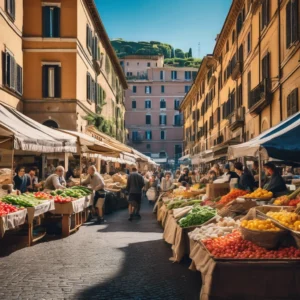
Testaccio Area What to do in Testaccio?
The Testaccio neighborhood, rich with history, dates back to the Roman Empire. Its proximity to the Tiber River made it Rome’s bustling port for unloading goods like olive oil, fresh fish, fruits, and grains — transported in ceramic pitchers, the remnants of which formed the famous Monte Testaccio hill.
Over centuries, discarded ceramic fragments accumulated, mixed with plant life, creating the unique hill known as Monte Testaccio — a remarkable landmark alongside the Egyptian-style Pyramid and the Aurelian Wall.
Today, Testaccio thrives with its famous market, offering fresh local produce and crafts, echoing the vibrant market life found in Pigneto and Trastevere.
Architectural highlights include examples of Fascist-era buildings alongside traces of Roman Empire heritage, making Testaccio a fascinating blend of history and culture.
To reach Testaccio by public transport, take Metro Line B to Pyramid station (four stops from Termini towards Laurentina). Bus lines 170, 280, 30, 3BUS, and 83 also serve the area, plus train lines FC2 and FL1 for outskirts travelers.
For more detailed info, visit our blog post on Public Transport in Rome.
Rome is a walkable city filled with charming squares and streets. We recommend using apps like Moovit or Google Maps for easy navigation.
Other Neighborhoods in Rome
🙏 Thank You for Reading!
Want to explore more about Rome? Check out our travel blog for helpful guides on the Vatican, Colosseum, Trastevere, and much more!
📰 Visit Our Blog for More Articles →
🚶♂️ Join One of Our Daily Tours in Rome!
Discover Rome with our free walking tours and premium experiences offered every day! We cover top sights like the Colosseum, Vatican, Jewish Ghetto, Trastevere, and more — with expert local guides.
Tours available in English, German, French, Spanish, and Portuguese — book your spot today!
🔍 View All Our Tours